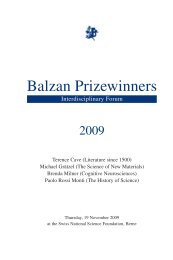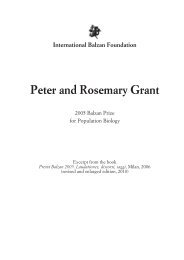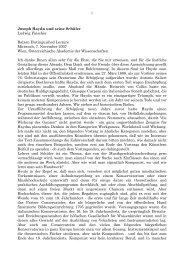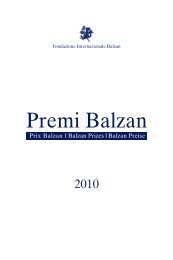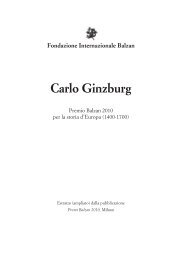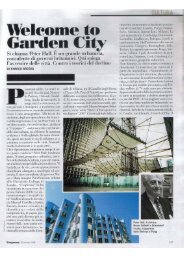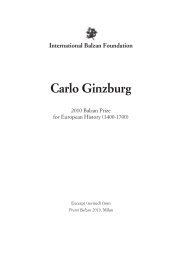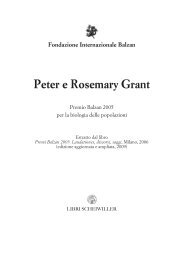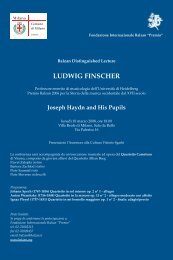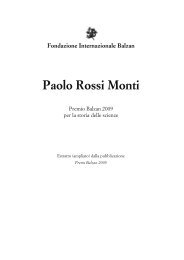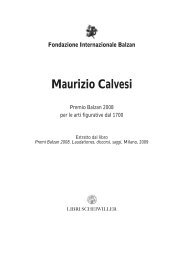Russell J. Hemley and Ho-kwang Mao
Russell J. Hemley and Ho-kwang Mao
Russell J. Hemley and Ho-kwang Mao
You also want an ePaper? Increase the reach of your titles
YUMPU automatically turns print PDFs into web optimized ePapers that Google loves.
2005 Balzan Prize<br />
Dense Hydrogen: The Most Abundant “Mineral”<br />
<strong>Hemley</strong> <strong>and</strong> <strong>Mao</strong>’s work has led to a series of discoveries concerning dense hydrogen,<br />
the most abundant mineral in the visible universe. Vitaly L. Ginzburg,<br />
the Russian theoretical physicist <strong>and</strong> 2003 Nobel Laureate, termed the behavior<br />
of hydrogen at high pressures as one of the “Key Problems of Physics <strong>and</strong> Astrophysics”<br />
in his seminal book by that name. 10 Indeed, just as the development of<br />
the theory of first the atom 11 <strong>and</strong> then the chemical bond 7 began with hydrogen,<br />
our underst<strong>and</strong>ing of materials at high density, including the constituents of planetary<br />
interiors, must begin with proper underst<strong>and</strong>ing of hydrogen at very high<br />
compression, as described in the classic 1935 paper on metallic hydrogen by Eugene<br />
Wigner <strong>and</strong> Hilliard B. Huntington. 12 <strong>Hemley</strong> was led to this problem by<br />
two pre-eminent mentors at Harvard, Martin Karplus (Pauling’s last graduate student)<br />
<strong>and</strong> Dudley R. Herschbach (1986 Nobel Laureate in Chemistry).<br />
Their initial studies led immediately to the first experimental observations <strong>and</strong><br />
measurements of hydrogen at megabar pressures [Phys. Rev. Lett. 55, 99 (1985)].<br />
This was followed by discoveries of several transformations, <strong>and</strong> key aspects of<br />
the system were characterized, as summarized in approximately 100 experimental<br />
<strong>and</strong> theoretical papers with numerous collaborators [see e.g., Rev. Mod. Phys.<br />
66, 671 (1994)]. This work included the first very high-pressure X-ray measurements<br />
on hydrogen, the first experiments at megabar pressures, determination<br />
of sound velocity in dense hydrogen, determination of the high-pressure dielectric<br />
properties, optical observations at multimegabar pressures, high-pressure<br />
electrical conductivity of the material <strong>and</strong>, most recently, the first static high pressure-temperature<br />
measurements above 1000 K <strong>and</strong> 1 Mbar. These studies continue<br />
to this day.<br />
The most crucial discovery was that of the major transformation in hydrogen at<br />
1.5 Mbar [Phys. Rev. Lett. 61, 587 (1988)]. This was unexpected <strong>and</strong> led to numerous<br />
subsequent studies of hydrogen around the world, including a systematic<br />
series of experimental <strong>and</strong> theoretical investigations. These studies revealed,<br />
for example, that the phase diagram of hydrogen <strong>and</strong> its isotopes is extraordinarily<br />
rich. With increasing pressure, the materials undergo a series of transitions,<br />
starting with pressure-induced ordering of the freely rotating molecules of<br />
the solid first identified by Pauling in 1930, 13 <strong>and</strong> culminating in structures in<br />
which the molecules strongly interact <strong>and</strong> exhibit an unusual combination of<br />
12



